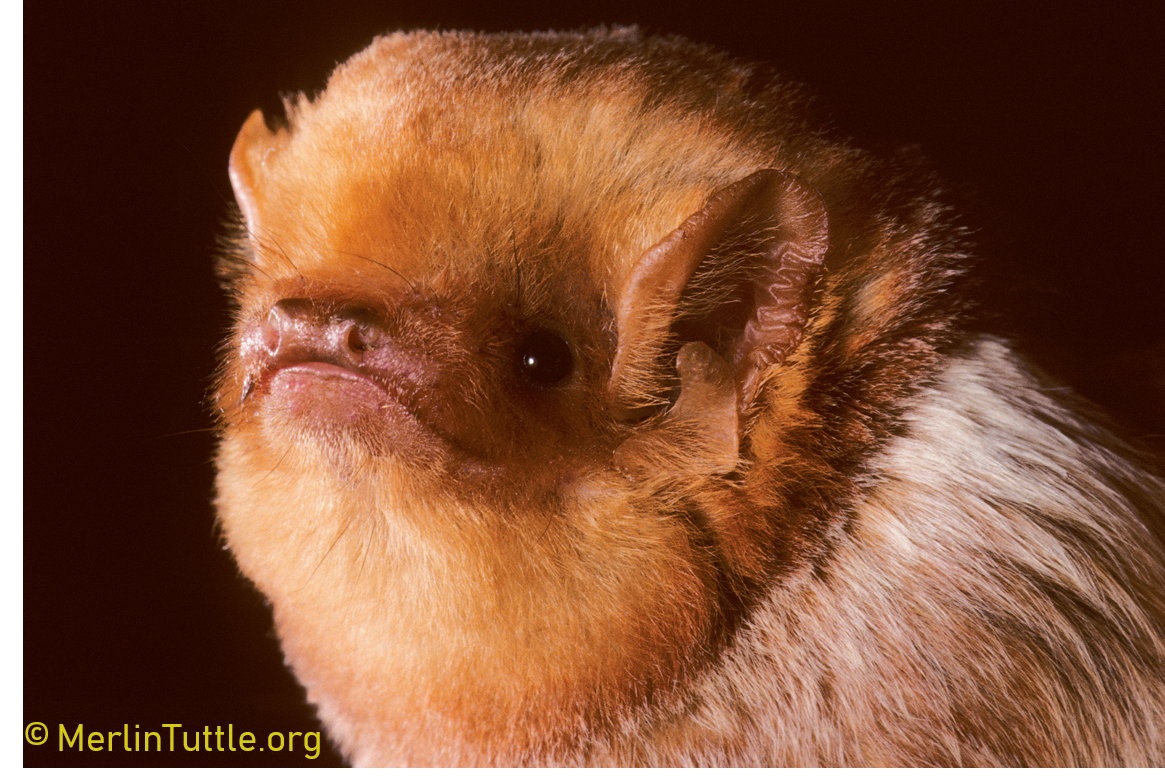Eastern red bat (Lasiurus borealis)
Description: The eastern red bat is a medium-sized bat with colorful fur. Males are more brightly colored than females, a rare trait because sexual dimorphism is uncommon in bats. The fur of males is brick red to reddish orange (sometimes yellowish red), while females are duller and lighter in coloration. In both sexes, the tips of their hairs are white, giving these bats a frosted appearance. The eastern red bat and closely related Seminole bat may appear identical, but can be distinguished by the color of their fur.
Roosting behavior: The eastern red bat is a solitary, tree-roosting species. It hangs by one foot from the foliage, depicting a dead leaf. They tend to select locations within tree foliage that is concealed from the sides and above but open below, to enable them to drop quickly and take flight. They stay warm by wrapping their long, thickly furred tail membrane around its underside and wings.
Diet: Eastern red bats eat moths, beetles, mosquitoes, leaf-hoppers and plant-hoppers, flies, and other insects. Aerial feeders, they forage above the tree tops and over streams. They also have been known to glean insects by landing briefly on tree branches and on the ground.
Morphological characteristics: Ears are short and rounded with a short, rectangular tragus. Tip of tragus curves forward and is rounded. The tail membrane is relatively long with a heavily furred dorsal surface.
Range: In Florida, eastern red bats are primarily found in the northern portion of the state, with their abundance decreasing towards the east coast and southward into the peninsula.
Remarks: Preserving hardwood forests is essential to ensure the survival of this tree-dwelling species.
Roosting behavior: The eastern red bat is a solitary, tree-roosting species. It hangs by one foot from the foliage, depicting a dead leaf. They tend to select locations within tree foliage that is concealed from the sides and above but open below, to enable them to drop quickly and take flight. They stay warm by wrapping their long, thickly furred tail membrane around its underside and wings.
Diet: Eastern red bats eat moths, beetles, mosquitoes, leaf-hoppers and plant-hoppers, flies, and other insects. Aerial feeders, they forage above the tree tops and over streams. They also have been known to glean insects by landing briefly on tree branches and on the ground.
Morphological characteristics: Ears are short and rounded with a short, rectangular tragus. Tip of tragus curves forward and is rounded. The tail membrane is relatively long with a heavily furred dorsal surface.
Range: In Florida, eastern red bats are primarily found in the northern portion of the state, with their abundance decreasing towards the east coast and southward into the peninsula.
Remarks: Preserving hardwood forests is essential to ensure the survival of this tree-dwelling species.
At a glance:
Measurements |
Categories |
Wingspan: 280-330 mm (12 inches) |
Family: Vespertilionidae |
Body length: 51-61 mm (2 and 1/4 inches) |
Florida occurrence: Resident |
Total length: 90-123 mm (4 and 1/4 inches) |
Florida status: Common in range |
Forearm length: 35-45 mm |
Roosting behavior: Solitary |
Weight: 9-15 g |
Regional classification: Temperate |
Bats of Florida by
Cynthia S. Marks and George E. Marks; Sep 26, 2006
Cynthia S. Marks and George E. Marks; Sep 26, 2006

